CRI, light intensity, color temperature, depth of field… these concepts can sometimes seem confusing on a surgical lighting datasheet. Yet understanding these criteria is essential for choosing the right lamp and ensuring optimal visibility in the operating room. Shadow reduction, laminar flow compliance, and advanced Surgiris technologies: all these elements serve the surgeon’s comfort and precision.
Understanding the importance of surgical lighting
In an operating room, the quality of surgical lighting plays a crucial role in procedural accuracy, patient safety, and the visual comfort of the medical team. Effective lighting must accurately render colors, eliminate shadow areas, and provide uniform intensity, regardless of surgical conditions.
To select the right medical lighting, it is essential to know how to read and interpret the information on a technical datasheet. Although often seen as purely technical, these data points translate into tangible performance metrics: color rendering, color temperature, light intensity, and more.
At Surgiris, a French designer and manufacturer of surgical lighting, every technical value corresponds to a specific clinical requirement. Understanding these parameters ensures surgeons a precise and natural vision, supporting operative performance.
1. CRI: a crucial criterion for surgical lighting
The CRI, or Color Rendering Index, measures a light source’s ability to accurately reproduce the natural colors of illuminated objects. Expressed as the Ra value, it ranges from 0 to 100: the higher the number, the closer the light is to natural daylight.
In the medical field, and particularly for surgical lighting, this metric is essential. Surgeons need to distinguish subtle tissue shades, identify vascular areas, and recognize anatomical structures without color distortion. A CRI below 80 is considered insufficient for medical use, while high-end surgical lights often exceed 95 Ra, ensuring near-perfect color fidelity.
However, the standard CRI is based on eight reference colors (R1 to R8). Some critical surgical colors are not included in this series:
-
R9 (red): essential for visualizing blood and vascular structures.
-
R13 and R15: corresponding to the tones of fair and Asian skin, crucial for dermatological or plastic surgery applications.
This is why Surgiris surgical lights, such as the XMT range, go beyond a simple Ra 99, with R9 at 99 and R13 at 99, delivering precise and faithful color rendering across the entire surgical field. This performance ensures surgeons enjoy balanced, comfortable vision, reducing eye strain during long procedures.
By combining a high CRI with controlled light uniformity, Surgiris guarantees optimal visual quality in the operating room, fully meeting the strictest clinical requirements.
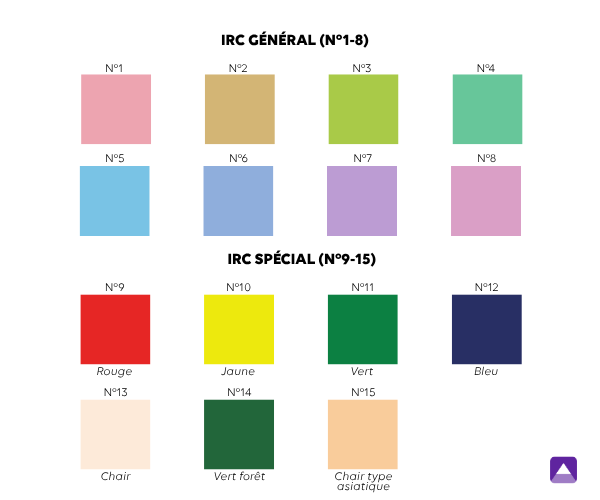
2. Light intensity and color temperature: mastering operating room illumination
What is central illuminance (Ec)?
Light intensity is a fundamental parameter of any surgical lighting system. It determines the amount of illumination available on the surgical field and directly impacts the precision of the surgeon’s movements. This intensity is measured in lux, with values varying depending on the requirements of each procedure.
Central illuminance, or Ec, refers to the maximum light density at the center of the surgical field. In other words, it is the area where light is most intense and where the surgeon’s visibility is optimal. This value is measured in lux.
At Surgiris, our XMT and EPURE operating lights provide a central illuminance (Ec) of 160,000 lux, delivering a powerful light core for critical surgical areas.
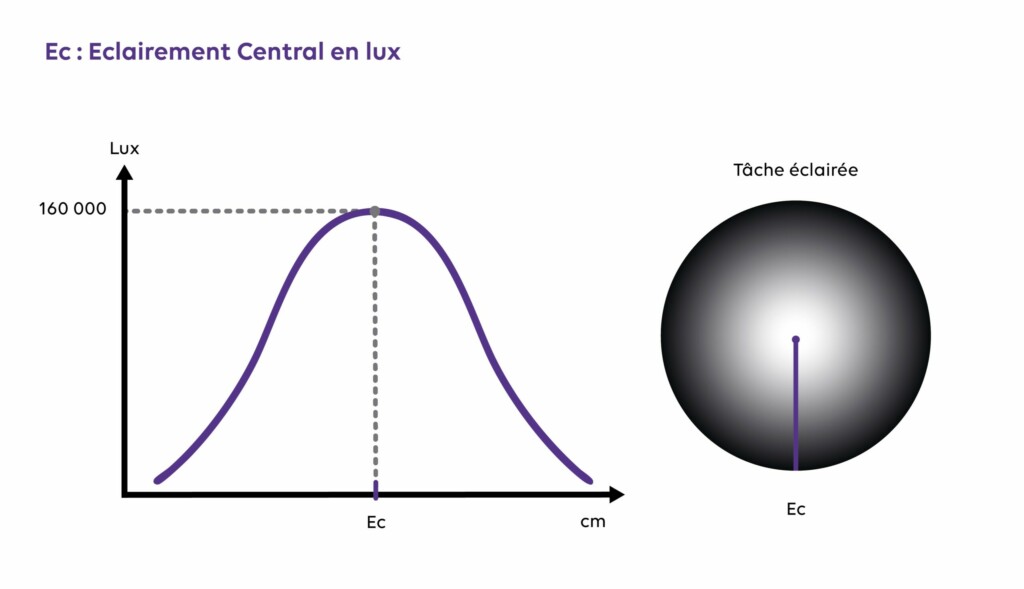
Depth of field: L1 + L2
The depth of field, noted as L1 + L2, refers to the distance over which the light remains sufficiently intense to allow the surgeon to operate under optimal visual conditions.
It is measured relative to the central illuminance (Ec), the area where the light reaches its maximum intensity.
Two reference thresholds are used in photometric testing:
-
At 60% Ec: corresponds to the area where the light remains at least 60% of its maximum intensity. This is the ideal working zone, where illumination is uniform and comfortable.
-
At 20% Ec: indicates how far the light remains usable, even at the periphery or in the deeper parts of the surgical field. This reflects the lamp’s ability to penetrate deeply, for example, in abdominal or thoracic cavities.
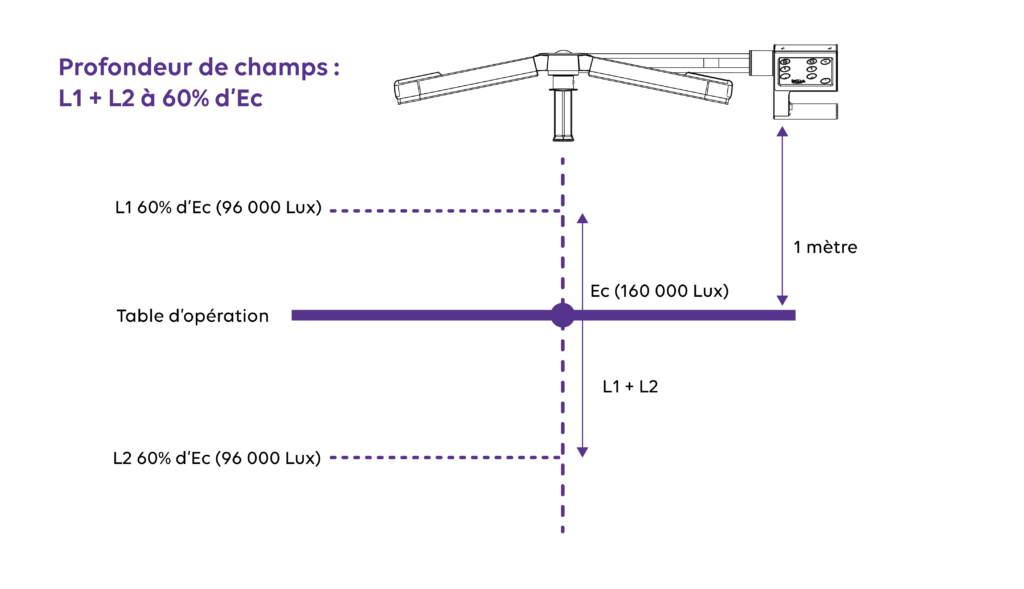
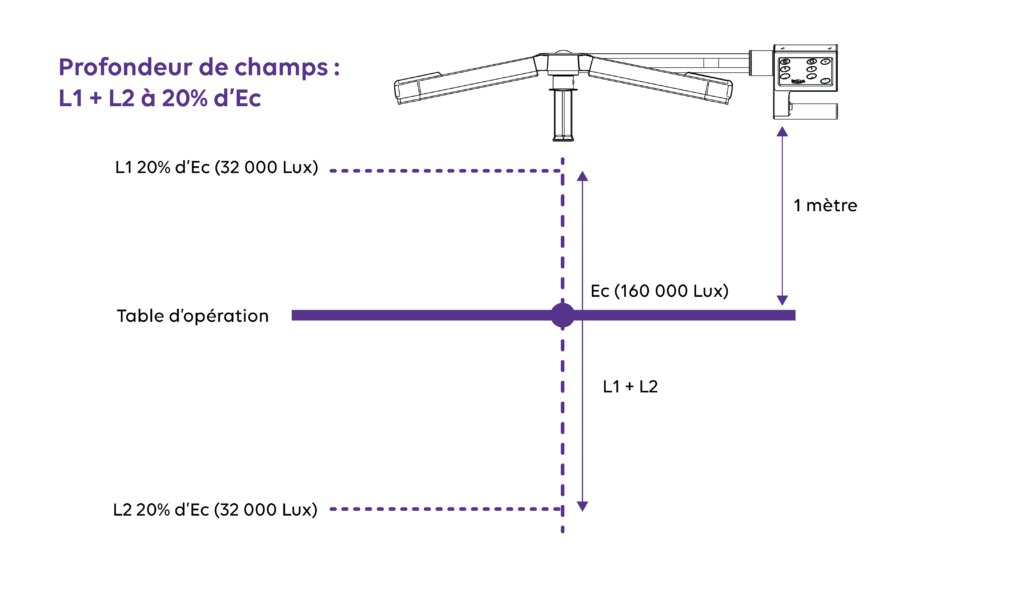
These values are not theoretical: they are measured in laboratories according to IEC 60601-2-41 standards, based on the light distribution curve of each model.
For example:
-
XMT range: depth of field is 70 cm at 60% Ec and 130 cm at 20% Ec.
-
EPURE range: depth of field reaches 69 cm at 60% Ec and 136 cm at 20% Ec.
These results reflect Surgiris lighting systems’ ability to maintain stable and uniform light intensity over a large depth, ensuring optimal visibility regardless of the surgeon’s position or the type of procedure.
Light field diameter: D10 and D50
The light field diameter indicates the actual area illuminated by the surgical lamp. It is measured using two reference values, D10 and D50, determined from the central illuminance (Ec).
-
D50: represents the diameter of the light core, the area where intensity remains at 50% of the central illuminance. This is the most concentrated and uniform part of the beam.
-
D10: corresponds to the total diameter of the surgical field, where light intensity drops to 10% of the central illuminance. This defines the outer limit of the light beam.
Both values are essential to assess the effective coverage of the surgical field and the light distribution. A good balance between D10 and D50 ensures uniform lighting without shadow areas, while avoiding a beam that is too wide or too concentrated.
Values vary slightly depending on the optical design of each model:
-
X3MT lighting: D10 = 33 cm, D50 = 17 cm
-
EPURE lighting: D10 = 27 cm, D50 = 18 cm
These figures demonstrate that both ranges provide broad light coverage, suitable for the surgical field size, while maintaining strong intensity at the beam’s center. This allows surgeons to precisely adjust the illuminated area based on the type of procedure and the required level of detail.

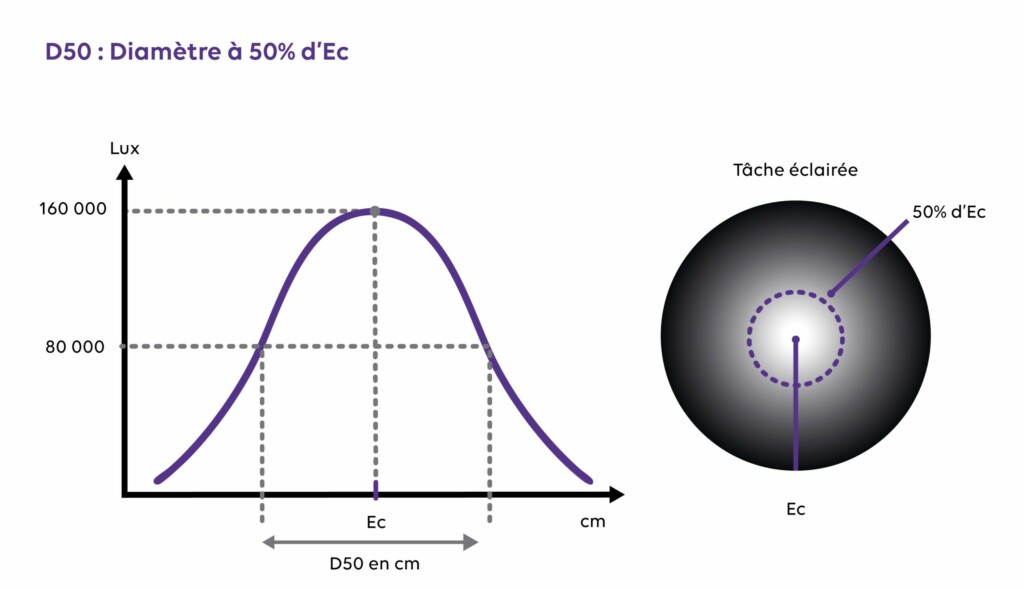
Color temperature: adapting light to surgical needs
Color temperature, expressed in Kelvin (K), defines the visual hue of the light emitted by surgical lighting.
It directly influences color perception, visual contrast, and the surgeon’s comfort in the operating room.
-
Low temperature (around 3,500 K): produces a warm, slightly amber light. It is gentler on the eyes and reduces visual fatigue during long procedures.
-
High temperature (around 5,000 K): corresponds to cool light, close to natural daylight. It enhances visual precision and the fine differentiation of tissues.
Both Surgiris surgical light ranges, XMT and EPURE, offer the same adjustable color temperature range:
3,500 K – 4,000 K – 4,500 K – 5,000 K
This flexibility allows the surgeon to select the most suitable light hue for each specialty or personal preference:
-
Warmer light for long surgeries or procedures requiring increased visual comfort.
-
Cooler light for disciplines where contrast clarity and tissue differentiation are crucial, such as vascular or plastic surgery.
By enabling color temperature adjustment, the XMT and EPURE ranges provide customized surgical lighting, combining performance, ergonomics, and optimal visual comfort for the practitioner.

3. Advanced technologies: performance and comfort in the operating room
Choosing a surgical light is not limited to checking CRI, central illuminance, depth of field, or beam diameter. Two additional criteria are essential to ensure optimal quality in the operating room:
Shadow reduction
In an operating room, the presence of shadows on the surgical field can hinder the surgeon’s visibility and increase the risk of errors. Shadow reduction is therefore a crucial criterion for high-performance surgical lighting. It ensures that even when obstacles—such as heads or instruments—come between the light source and the surgical area, the illumination remains uniform and consistent.
Thanks to Surgiris’ unique multi-spot light overlay technology, each module emits light independently, creating a homogeneous beam free of shadowed areas. This design ensures optimal visibility, reduces visual fatigue, and allows for precise surgical maneuvers throughout the procedure.
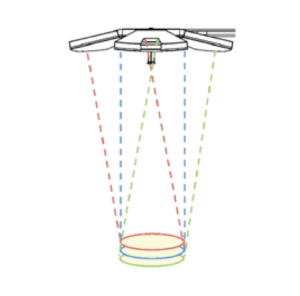
Laminar airflow disruption
Laminar airflow refers to the sterile air circulation in an operating room. It is designed to prevent contamination of the surgical field by particles or bacteria. Excessive disruption of this airflow can compromise hygiene and increase the risk of post-operative infections.
Any lighting installed in the operating room can affect this flow. For this reason, DIN 1946‑4 standards recommend that the maximum disruption of laminar airflow should not exceed 37.5%.
Laminar airflow disruption measures the impact of a light on this air movement: the lower the percentage, the less the lighting interferes with sterile air circulation. Surgiris lights comfortably meet this requirement:
-
XMT: laminar airflow disruption 28%, significantly limiting particle dispersion and ensuring a safe environment.
-
EPURE: laminar airflow disruption 32%, while maintaining powerful, uniform illumination.
These values ensure that sterile air circulates effectively while maintaining maximum light intensity at the center of the surgical field, providing both safety and optimal visibility.

Beyond light: our technologies supporting the operating room
In addition to standard performance features such as a high R9, elevated Ec, or suitable depth of field, Surgiris also offers advanced patented technologies to enhance comfort, precision, and reliability in the operating room:
-
FOCUSMATIC: electronic focusing of the light field without any loss of intensity.
-
MOTION MATIC: contactless adjustments directly within the sterile area.
-
EFA, CCL, APM, and WCT: algorithms and systems ensuring stable color rendering, durable performance, and wireless control.
To explore all advanced features and associated patents, you can refer to our dedicated article.
Have a project in mind? Contact our sales team to learn more.



